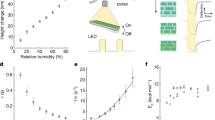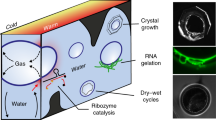Abstract
The disaccharide trehalose is accumulated by microorganisms, such as yeasts, and multicellular organisms, such as tardigrades1,2, when conditions of extreme drought occur. In this way these organisms can withstand dehydration through the formation of an intracellular carbohydrate glass, which, with its high viscosity and hydrogen-bonding interactions3,4, stabilizes and protects the integrity of complex biological structures and molecules. This property of trehalose can also be harnessed in the stabilization of liposomes5, proteins6 and in the preservation of red blood cells7, but the underlying mechanism of bioprotection is not yet fully understood. Here we use positron annihilation lifetime spectroscopy to probe the free volume of trehalose matrices; specifically, we develop a molecular picture of the organization and mobility of water in both amorphous and crystalline states. Whereas in amorphous matrices, water increases the average intermolecular hole size, in the crystalline dihydrate it is organized as a confined one-dimensional fluid in channels of fixed diameter that allow activated diffusion of water in and out of the crystallites. We present direct real-time evidence of water molecules unloading reversibly from these channels, thereby acting as both a sink and a source of water in low-moisture systems. We postulate that this behaviour may provide the overall stability required to keep organisms viable through dehydration conditions.
This is a preview of subscription content, access via your institution
Access options
Subscribe to this journal
Receive 12 print issues and online access
$259.00 per year
only $21.58 per issue
Buy this article
- Purchase on Springer Link
- Instant access to full article PDF
Prices may be subject to local taxes which are calculated during checkout



Similar content being viewed by others
References
Crowe, J. H. & Crowe, L. M. Preservation of mammalian cells—learning nature's tricks. Nature Biotechnol. 18, 145–146 (2000).
Guo, N., Puhlev, I., Brown, D. R., Mansbridge, J. & Levine, F. Trehalose expression confers desiccation tolerance on human cells. Nature Biotechnol. 18, 168–171 (2000).
Crowe, J. H., Crowe, L. M. & Chapman, D. Preservation of membranes in anhydrobiotic organisms: The role of trehalose. Science 223, 701–703 (1984).
Crowe, J. H., Carpenter, J. F. & Crowe, L. M. The role of vitrification in anhydrobiosis. Ann. Rev. Physiol. 60, 73–103 (1998).
Crowe, L. M. et al. Prevention of fusion and leakage in freeze-dried liposomes by carbohydrates. Biochim. Biophys. Acta 861, 131–136 (1986).
Cicerone, M. T. & Soles, C. L. Fast dynamics and stabilization of proteins: Binary glasses of trehalose and glycerol. Biophys. J. 86, 3836–3845 (2004).
Wolkers, W. F., Walker, N. J., Tamari, Y., Tablin, F. & Crowe, J. H. Towards a clinical application of freeze-dried human platelets. Cell Preserv. Technol. 1, 175–188 (2003).
Brown, G. M. et al. The crystal structure of α,α-trehalose dihydrate from three independent X-ray determinations. Acta Crystallogr. B 28, 3145–3158 (1972).
Taga, T., Senma, M. & Osaki, K. The crystal and molecular structure of trehalose dihydrate. Acta Crystallogr. B 28, 3258–3263 (1972).
Sussich, F., Skopec, C., Brady, J. & Cesàro, A. Reversible dehydration of trehalose and anhydrobiosis: from solution state to an exotic crystal? Carbohydr. Res. 334, 165–176 (2001).
McGarvey, O. S., Kett, V. L. & Craig, D. Q. M. An investigation into the crystallization of α,α-trehalose from the amorphous state. J. Phys. Chem. B 107, 6614–6620 (2003).
Sussich, F., Bortoluzzi, S. & Cesàro, A. J. Trehalose dehydration under confined conditions. Thermochim. Acta 391, 137–150 (2002).
Green, J. L. & Angell, C. A. Phase relations and vitrification in saccharide-water solutions and the trehalose anomaly. J. Phys. Chem. 93, 2880–2882 (1989).
Willart, J. F., Danede, F., De Gusseme, A., Descamps, M. & Neves, C. Origin of the structural transformation of trehalose dihydrate upon dehydration. J. Phys. Chem. B 107, 11158–11162 (2003).
Furuki, T., Kishi, A. & Sakurai, M. De- and rehydration behaviour of α,α-trehalose dihydrate under humidity-controlled atmospheres. Carbohydr. Res. 340, 429–438 (2005).
Sussich, F., Urbani, R., Princivalle, F. & Cesàro, A. Polymorphic amorphous and crystalline forms of trehalose. J. Am. Chem. Soc. 120, 7893–7899 (1998).
Crowe, L. M., Reid, D. S. & Crowe, J. H. Is trehalose special for preserving dry biomaterials? Biophys. J. 71, 2087–2093 (1996).
Chen, T., Fowler, A. & Toner, M. L. Literature review: Supplemented phase diagram of the trehalose-water binary mixture. Cryobiology 40, 277–282 (2000).
Aldous, B. J., Auffret, A. D. & Franks, F. The crystallization of hydrates from amorphous carbohydrates. Cryo-Lett. 16, 181–186 (1995).
Pethrick, R. A. Positron annihilation—a probe for nanoscale voids and free volume? Prog. Polym. Sci. 22, 1–47 (1997).
Tao, T. J. Positronium annihilation in molecular substances. J. Chem. Phys. 56, 5499 (1972).
Eldrup, M., Lightbody, D. & Sherwood, J. N. The temperature dependence of positron lifetimes in solid pivalic acid. Chem. Phys. 63, 51–58 (1981).
Nakanishi, H., Wang, S. J. & Jean, Y. C. in Positron Annihilation Studies of Fluids (ed. Sharma, S. C.) 292 (World Scientific, Singapore, 1988).
Olson, B. G., Prodpran, T., Jamieson, A. M. & Nazarenko, S. Positron annihilation in syndiotactic polystyrene containing α and β crystalline forms. Polymer 43, 6775–6784 (2002).
Kilburn, D. et al. Water in glassy carbohydrates: Opening it up at the nanolevel. J. Phys. Chem. B 108, 12436–12441 (2004).
Kilburn, D., Claude, J., Schweizer, T., Alam, A. & Ubbink, J. Carbohydrate polymers in amorphous states: An integrated thermodynamic and nanostructural investigation. Biomacromolecules 6, 864–879 (2005).
Mogenson, O. Positron Annihilation in Chemistry (Springer, Berlin, 1995).
Franks, F. Water Second Edition: A Matrix of Life (The Royal Society of Chemistry, Cambridge, 2000).
Crank, J. The Mathematics of Diffusion 2nd edn, Ch. 4, 48 (Oxford Univ. Press, Oxford, 1975) Eq. (4.18).
Suresh, S. J. & Naik, V. M. Hydrogen bond thermodynamic properties of water from dielectric constant data. J. Chem. Phys. 113, 9727–9732 (2000).
Tromp, R. H., Parker, R. & Ring, S. G. Water diffusion in glasses of carbohydrates. Carbohydr. Res. 303, 199–205 (1997).
Taylor, L. S. & York., P. Characterization of the phase transitions of trehalose dihydrate on heating and subsequent dehydration. J. Pharm. Sci. 87, 347–355 (1998).
Acknowledgements
We thank M.-I. Alonso and J.-P. Marquet for technical assistance. This research was sponsored by a postdoctoral grant from Nestec Ltd to the University of Bristol (D.K.).
Author information
Authors and Affiliations
Corresponding author
Ethics declarations
Competing interests
The authors declare no competing financial interests.
Rights and permissions
About this article
Cite this article
Kilburn, D., Townrow, S., Meunier, V. et al. Organization and mobility of water in amorphous and crystalline trehalose. Nature Mater 5, 632–635 (2006). https://doi.org/10.1038/nmat1681
Received:
Accepted:
Published:
Issue Date:
DOI: https://doi.org/10.1038/nmat1681
This article is cited by
-
Proton, thermal and mechanical relaxation characteristics of a complex biomaterial (de-fatted date-pits) as a function of temperature
Journal of Thermal Analysis and Calorimetry (2023)
-
Unforeseen crystal forms of the natural osmolyte floridoside
Communications Chemistry (2020)
-
Positronium in medicine and biology
Nature Reviews Physics (2019)
-
Exploring Molecular Speciation and Crystallization Mechanism of Amorphous 2-Phenylamino Nicotinic Acid
Pharmaceutical Research (2018)
-
Imprisoned lightning: charge transport in trehalose-derived sugar glasses
Ionics (2015)



